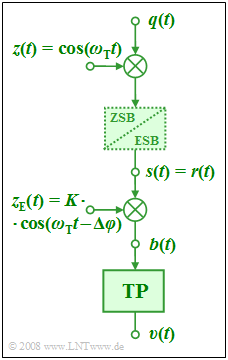Difference between revisions of "Aufgaben:Exercise 2.6Z: Synchronous Demodulator"
m (Guenter moved page Aufgabe 2.6Z: Synchrondemodulator to Exercise 2.6Z: Synchronous Demodulator) |
|||
| Line 86: | Line 86: | ||
- A phase shift $\Delta \varphi \ne 0$ results in attenuation distortions. | - A phase shift $\Delta \varphi \ne 0$ results in attenuation distortions. | ||
+ A phase shift $\Delta \varphi \ne 0$ results in phase distortions. | + A phase shift $\Delta \varphi \ne 0$ results in phase distortions. | ||
| − | - $v(t) = q(t)/2$ with $\Delta \varphi = \hspace{-0.05cm}-\hspace{0.05cm}60^\circ$ . | + | - $v(t) = q(t)/2$ holds with $\Delta \varphi = \hspace{-0.05cm}-\hspace{0.05cm}60^\circ$ . |
Revision as of 15:16, 20 September 2021
The depicted block diagram shows a transmission system
- with Double-Sideband Amplitude Modulation (ZSB-AM)
- and Synchronous Demodulation (SD).
Let the source signal consist of two harmonic oscillations with frequencies $f_2 = 2 \ \rm kHz$ and $f_5 = 5 \ \rm kHz$:
- $$q(t) = {2 \, \rm V} \cdot {\rm cos}(\omega_2 t )+ {1 \, \rm V} \cdot {\rm sin}(\omega_5 t ) .$$
- This signal is multiplied by the dimensionless carrier signal $z(t) = \cos(\omega_{\rm T} \cdot T)$ of frequency $f_{\rm T} = 50 \ \rm kHz$. For ZSB–AM the dashed block is irrelevant so that the following holds for the transmit signal:
- $$s(t) = q(t) \cdot {\rm cos}(\omega_{\rm T} t ) .$$
- In the synchronous demodulator, the receiver signal $r(t)$ – dentical to the transmit signal $s(t)$ in an ideal channel – is multiplied by the receive-site carrier signal $z_{\rm E}(t)$ where the following applies:
- $$z_{\rm E}(t) = K \cdot {\rm cos}(\omega_{\rm T} t - \Delta \varphi ) .$$
- This signal should not only be frequency-synchronous with $z(t)$ but also phase-synchronous – hence the name "synchronous demodulator".
- The above approach takes into account a phase shift between $z(t)$ and $z_{\rm E}(t)$, which should ideally be $\Delta \varphi = 0$ but often cannot be avoided in real systems.
- The output signal $b(t)$ of the second multiplier includes components around twice the carrier frequency in addition to the desired NF component.
- Using an ideal low-pass filter– for example with cut-off frequency $f_{\rm T}$ – the sink signal $v(t)$ can be obtained which ideally should be equal to the source signal $q(t)$ .
For the transmitter, multiplication by the carrier signal $z(t)$ generally results in two sidebands. In the Single-Sideband Modulation (ESB–AM) only one of the two bands is transmitted, for example the lower sideband (USB). Thus, the following is obtained with an ideal channel:
- $$r(t) = s(t)= {1 \, \rm V} \cdot {\rm cos}\big [(\omega_{\rm T} - \omega_2 )\cdot t \big ] - {0.5 \, \rm V} \cdot {\rm sin}\big [(\omega_{\rm T} - \omega_5 )\cdot t \big ] .$$
- Here, synchronous demodulation results in the following distorted sink signal considering a phase shift $\Delta \varphi$, the constant $K = 4$ and the downstream low-pass filter:
- $$v(t)= {1 \, \rm V} \cdot {1}/{2}\cdot 4 \cdot{\rm cos}( \omega_2 t - \Delta \varphi)+ {0.5 \, \rm V} \cdot {1}/{2}\cdot 4 \cdot{\rm sin}( \omega_5 t - \Delta \varphi)$$
- $$\Rightarrow \hspace{0.5cm}v(t)= {2 \, \rm V} \cdot{\rm cos}( \omega_2 t - \Delta \varphi)+ {1 \, \rm V} \cdot{\rm sin}( \omega_5 t - \Delta \varphi)$$
- In the ideal case of phase-synchronous demodulation $(\Delta \varphi = 0)$, $v(t) = q(t)$ holds again.
Please note:
- The task belongs to the chapter Linear Distortions.
- The topic "amplitude modulation/synchronous demodulator" is discussed in detail in the book Modulation Methods .
- The following trigonometric relationships are given:
- $$\cos^2(\alpha) = {1}/{2} \cdot \big [ 1 + \cos(2\alpha) \big ] \hspace{0.05cm}, $$
- $$\cos(\alpha) \cdot \cos(\beta) = {1}/{2} \cdot \big[ \cos(\alpha - \beta)+ \cos(\alpha + \beta) \big],$$
- $$ \sin(\alpha) \cdot \cos(\beta) = {1}/{2} \cdot \big[ \sin(\alpha - \beta)+ \sin(\alpha + \beta) \big] \hspace{0.05cm}.$$
Questions
Solution
- $$b(t) = r(t) \cdot z_{\rm E}(t)= q(t) \cdot z(t) \cdot z_{\rm E}(t)= K \cdot q(t)\cdot \cos^2(\omega_{\rm T} t).$$
- Using the trigonometric relation $\cos^2(\omega_{\rm T} t) = {1}/{2} \cdot\big[ 1 + \cos(2\omega_{\rm T} t)\big]$,
- $$b(t) = {K}/{2} \cdot q(t) + {K}/{2} \cdot q(t)\cdot \cos(2\omega_{\rm T} t)$$ is obtained.
- Der zweite Anteil liegt um die doppelte Trägerfrequenz ⇒ $2 f_{\rm T}$.
- Dieser wird durch den Tiefpass $($mit der Grenzfrequenz $ f_{\rm G} = f_{\rm T})$ entfernt.
- Damit erhält man: $v(t) = {K}/{2} \cdot q(t) .$
- Mit $\underline {K = 2}$ ergibt sich eine ideale Demodulation ⇒ $v(t) = q(t)$.
(2) Unter Berücksichtigung der Beziehung
- $$\cos(\omega_{\rm T} t) \cdot \cos(\omega_{\rm T} t - \Delta \varphi) = {1}/{2} \cdot \big[ \cos(\Delta \varphi)+ \cos(2\omega_{\rm T} t - \Delta \varphi) \big]$$
sowie des nachgeschalteten Tiefpasses, der wieder den Anteil um die doppelte Trägerfrequenz entfernt, erhält man hier mit $ {K = 2}$:
- $$v(t) = q(t) \cdot \cos(\Delta \varphi).$$
Richtig sind die Lösungsvorschläge 2 und 5:
- Ein Phasenversatz $\Delta \varphi$ führt hier nur zu einer frequenzunabhängigen Dämpfung und nicht zu Dämpfungs– oder Phasenverzerrungen.
- Ein Phasenversatz um $\varphi =\pm 60^\circ$ hat jeweils eine Halbierung des Signals zur Folge.
(3) Richtig ist hier der Lösungsvorschlag 4.
- Bei beiden Summanden tritt genau der gleiche Phasenversatz $\Delta \varphi$ auf, und es kommt hier zu Phasenverzerrungen:
- $$v(t)= {2 \, \rm V} \cdot{\rm cos}\big[ \omega_2 \cdot (t - \tau_2) \big]+ {1 \, \rm V} \cdot{\rm sin}\big[ \omega_5 t \cdot (t - \tau_5)\big],$$
- $${\rm wobei}\hspace{0.5cm}\tau_2 = \frac{\Delta \varphi}{\omega_2} \hspace{0.5cm}\ne \hspace{0.5cm} \tau_5 = \frac{\Delta \varphi}{\omega_5}.$$
- Ein Phasenversatz von $\varphi =60^\circ$ entsprechend $\pi/3$ führt hier zu den Verzögerungszeiten:
- $$\tau_2 = \frac{\pi/3}{2 \pi \cdot 2\,\,{\rm kHz }} \approx 83.3\,{\rm µ s }, \hspace{0.5cm} \tau_5 = \frac{\pi/3}{2 \pi \cdot 5\,\,{\rm kHz }} \approx 33.3\,{\rm µ s }.$$
- Das niederfrequentere Signal wird also stärker verzögert.
